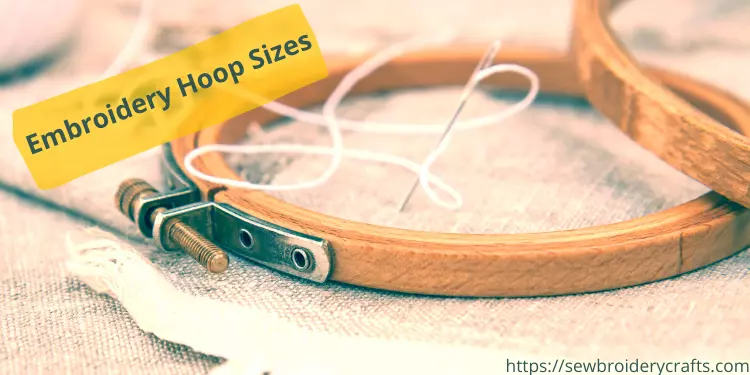
Embroidery hoop is an important constituent for embroidery machines. If you are an embroiderer, you will be well aware of the importance of hoops for cross stitching and embroidery work. In actuality, it’s not just a tool but you need to know a lot about this ubiquitous tool specially Embroidery hoop sizes. Do you ever wonder why hoops are available in different sizes? The reason is pretty simple: different designs require distinctive types of machine embroidery hoops as per embroidery sizes .
In this ultimate guide, I will discuss what machine embroidery hoop is, its types, embroidery hoop size chart, how to pick up the right embroidery hoop, and everything that you need to know about. Let’s begin!
What is an Embroidery Hoop?
Embroidery hoop is also known as the frame. It’s a special tool to keep the fabric stretched and taut while doing embroidery or any form of needle work. A hoop or frame consists of a twin of elliptical or circular rings to keep the fabric inside it.
But how to measure an embroidery hoop size? Well, the sizes of both rings are different and bigger rings are to be kept outside and a metal screw is there to tighten it. They are available in different sizes to work on small or large fabric. They are designed in such a way to work with a single hand and control it easily by keeping it in rest motion. Read more to check out what is the largest embroidery hoop size and much more.
Is It Essential To Use An Embroidery Hoop?
It usually depends on the embroiderer, embroidery type, embroidery size, machine embroidery design, embroidery hoop design and a few other factors such as stitching type, fabric that you are using and experience. It is particularly beneficial to keep the embroidery fabric stretched and better to go for multi hoop embroidery. It helps create beautiful & neat stitches and save the stitches from puckering due to spaces.
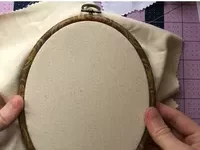
Also Read: 11 Best Embroidery Machines – Computerized Embroidery Machines for home
Furthermore, cross stitches always require a hoop because you can’t handle the holes without it. And here you need to be considerate upon cross stitch hoop sizes, specifically. When it comes to choosing a hoop type, you can use a 4 x 4 embroidery hoop, 2.5 inch embroidery hoop, 15 inch embroidery hoop or you need to choose according to the circumstances. It purely depends on many factors that we will discuss in the hoop types.
Important Types of Embroidery Hoops
Normally, all types of hoop for embroidery serve the same purpose of holding the fabric tightly. Nevertheless, it’s important to know about using an embroidery hoop according to hoop types. Check out the significant embroidery hoop types in the following:
Screw Tension Hoop
Screw tension- hand embroidery hoops is the most common type of embroidery hoop and has a screw at the outer ring. The attached screw lets you expand or lessen the tension of the hoop. They are readily available in different sizes, materials, and shapes.
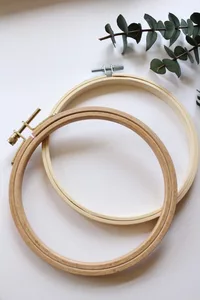
Spring Tension Hoop
In such types of plastic embroidery hoops, tension is generated via an inner ring that slots into a holt. This is also attached in a plastic outer embroidery ring. It is frequently used in cross-stitching and hand embroidery work. It nicely keeps the fabric tight. The only problem is the bulky handles.
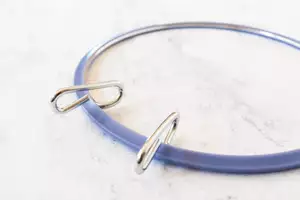
Flexi Hoop
Flexi hoop- metal embroidery hoop, gives a real look of quality wood and is crafted from malleable vinyl that gives perfect taut. People like it due to its stretching capability and its professionalism on how to put fabric in an embroidery hoop . Conversely, it’s a bit challenging to use them. Experts use it for framing a finished piece of embroidery work, not for stitching.
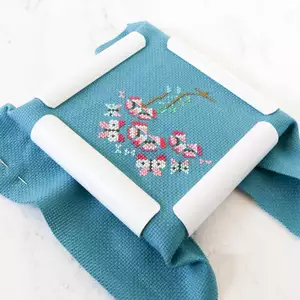
Q-Snaps Hoop
These embroidery hoops without screws are not technically hoops but a convenient tool for cross stitches. We like it among types of embroidery hoops due to its lightweight, availability in different sizes and comfortability to hold them.
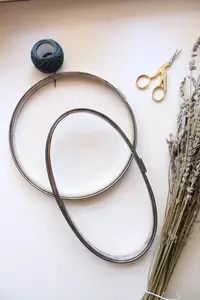
Regular Embroidery Machine Hoop Sizes
There are three frequently used embroidery hoop sizes in inches such as 4×4 embroidery hoop, embroidery machine 5×7 hoop, and embroidery machine 6 x 10 inches hoop. Some machines use only a single hoop, but some models utilize more than a single hoop. To know about it, please read the manual included with your embroidery machine. You can visit the brand’s official website to know about the accurate embroidery hoop sizes suitable for that specific model. Otherwise, we have also mentioned the machine embroidery hoop size chart in the following.
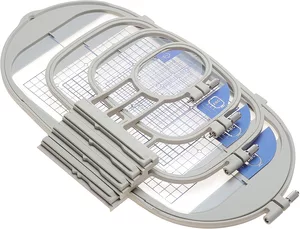
- For a 4”x4” hoop, the sewing field is about 3.94 x 3.94 inches.
- For a 5”x7” hoop, the sewing field is 5.12 x 7.09 inches.
- For a 6”x10” hoop, the sewing field is about 6.30 x 10,24 inches.
Embroidery Hoop Sizes Chart
| Hoop Size | Sewing Field |
|---|---|
| 4×4 inch | 100 x 100 mm |
| 5×7 inch | 130 x 180 mm |
| 6×10 inch | 160 x 260 mm |
| 8×10 inch | 200 x 260 mm |
| 8×8 inch | 200 x 200 mm |
Also Read: Brother SE400 Vs. Brother SE600 Sewing and Embroidery Machine
Embroidery Hoops: Plastic vs. Wood
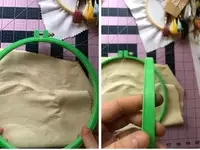
People are moving towards flexible embroidery hoop technology and cost-effective solutions; therefore, plastic embroidery hoop is inexpensive and always a beginner’s choice. Pick up an excellent quality plastic hoop that gives extra taut to the stitching fabric. Don’t forget to check the quality and reliability of plastic flexi hoops before buying. However, the only problem with plastic is that it can bend or warp if not carefully used.

Likewise, wooden hoops for embroidery are more reliable options and come in various sizes. You can choose the width, thickness according to your needs and requirements. Check the smooth round edges before buying a wooden hoop, and it doesn’t snag or splinter. The best embroidery hoops- wooden are fitted with brass fittings and long-lasting performance.
How to use an Embroidery Hoop?
Regardless of the style you have chosen, the primary procedure on how to put fabric in an embroidery hoop is similar. For your ease, we have mentioned the steps on how to use an embroidery hoop in the following:
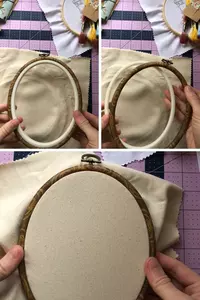
- First, unfasten the screw a little bit and separate both the inner and outer hoops. Drape the fabric that you want to use on the smaller hoop. For embroidery hoops without screws like flexi hoops, you just need to place the fabric in the boundary and stretch it as per your requirements.
- Set the fabric according to your requirements,hoop it all and put the bigger hoop on it. Keep in mind that the fabric should be stretched completely.
- Tighten the screw enough that the fabric remains stretched and does not loosen up.
- So, it’s all done. Enjoy your embroidery as you want.
Tips for Getting a Good Tensions of Embroidery Hoop
We want to share some useful tips that will make your experience better with embroidery hoops while using them:
Always keep the fabric tight, just like a drum. It will give you amazingly neat and clean stitches in needlework hoops.
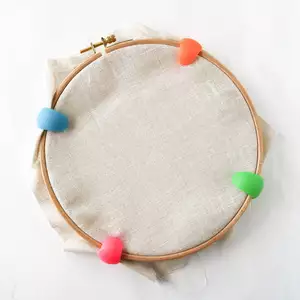
To get accurate tension, pull the fabric evenly from all the sides and tight it perfectly along the hoop. For this purpose, round hoops are preferred instead of rectangle embroidery hoops.
Tighten the screws by ensuring that the fabric does not slip while performing the stitches job. Use a foam grips frame for embroidery hoops if needed to help tighten the screws firmly.
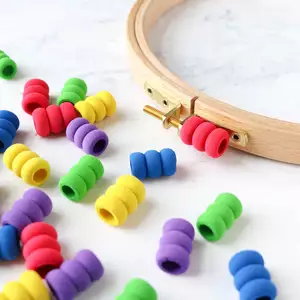
Wrap the small hoop with quality cotton twill tape to get more tension. This tip works best on wooden hoops for embroidery .
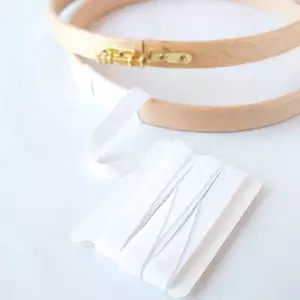
Final Words
So, it’s all about what to do with embroidery hoops, what is embroidery hoop, how to use embroidery hoops, machine embroidery hoop size chart, and all the necessary information. Don’t forget to follow our tips before working on any embroidery project. We hope you will find our efforts helpful.
Enjoy Your Embroidery!

Leave a Reply